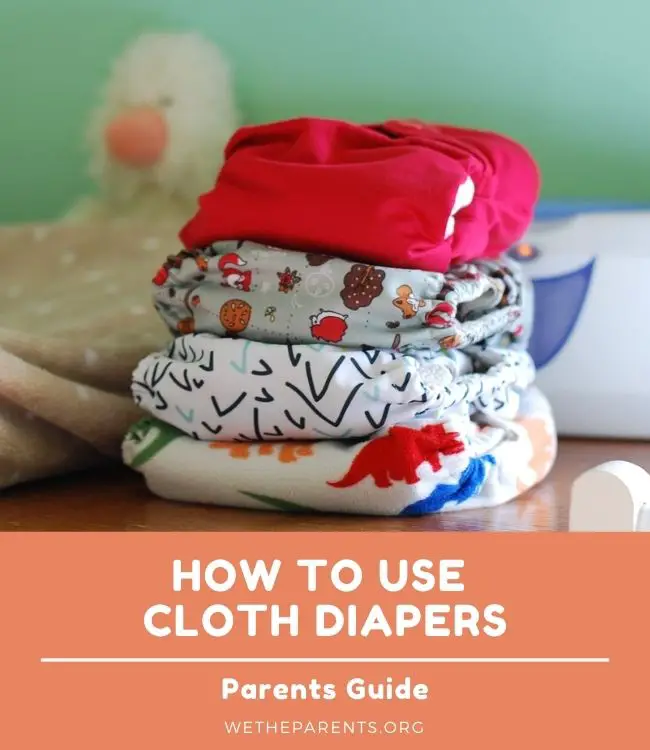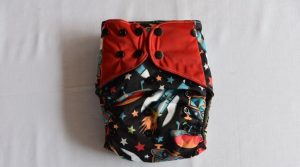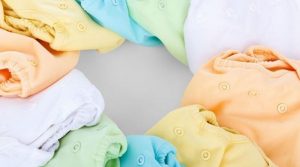Make the switch to these eco-friendly wallet savers and you may never look back!
Of all the experiences new parenthood throws our way, nappies are one that’s universal, much to our chagrin. Keeping a baby’s bum covered isn’t optional, and disposable diapers can become pricey — plus, they’re not good for the environment, especially at the rate that newborns get through them.1Meseldzija, J., Poznanovic, D., & Frank, R. (2013). Assessment of the differing environmental impacts between reusable and disposable diapers. Dufferin Research. Establishing the association between nonnutritive sucking behavior and malocclusions: a systematic review and meta-analysis. dufferinresearch.com
Many of today’s parents are now reaching for reusable cloth diapers, their modern styles offering variety and comparable functionality without the high cost and eco-unfriendliness of disposables.
Related: Best Cloth Diapers 2021 (Ultimate Guide & Top Picks)
How to use cloth diapers — the basics
Cloth diapers are simply nappies made of washable cloth material. They’re available in several different styles, and use either absorbent fabric or an absorbent insert to collect waste material.
Because they can be washed at home and are reusable, they’re typically considered more eco-friendly than their disposable counterparts.
However, the material that cloth diapers are made from determines the level to which this is true; bamboo viscose, and similar synthetic cloth for diapers, tend to generate a lot of pollution in their manufacture, whereas natural cotton alternatives do not.2Meseldzija, J., Poznanovic, D., & Frank, R. (2013). Assessment of the differing environmental impacts between reusable and disposable diapers. Dufferin Research. dufferinresearch.com
The use of cloth diapers requires keeping an adequate supply on hand and learning the ins and outs of washing, stripping, drying, and caring for baby’s diapers. Here we cover all that and more.
Why should I use cloth diapers?
Whether you’re a new parent who’s never changed a diaper in your life or a veteran, expecting mama who’s considering making the switch, here are the top two reasons to love cloth diapers.
- They cut cost: It’s no secret that disposable diapers cost a pretty penny, and the need for them doesn’t simply disappear overnight — it’s an ongoing cost until potty training is done. Making the switch to cloth diapering has the potential to save parents around $400 over the period of three years. healthychildren.org/English/ages-stages/baby/diapers-clothing/Pages/Buying-Diapers.aspx It’s even more cost-efficient if you’re planning on having more children as you’ll have their nappies ready to go, with only their maintenance products needed.
- They’re more environmentally friendly: The Environmental Protection Agency estimates that 4.15 million tons of diapers were dumped into landfills in 2017. It’s not known exactly how long it takes for a disposable diaper to break down, but we do know that disposable diapers account for a significant amount of landfill waste compared to other trash, and that landfill conditions may deprive them of the sunlight and oxygen that facilitate decomposition. We also know that they can contain polyethylene, polypropylene, and other heavy chemicals. These ingredients are present within the inner liner of disposable diapers and, though not in contact with a baby’s skin (creating possible medical risks), these chemicals are not good for the environment.3Counts, J., Weisbrod, A., & Yin, S. (2017). Common diaper ingredient questions: Modern disposable diaper materials are safe and extensively tested. Clinical pediatrics, 56(5_suppl), 926-934.23S-27S. journals.sagepub.com
Cloth diaper styles
There are several different styles of cloth diapers to choose from. You may wish to try a few, or even review them all — what your baby feels most comfortable with, and what fits and works most effectively, can vary from one child to another.
- Flat: These are truly old-school cloth diapers! This is the updated name for the very same folded cloth diapers mom and grandma used, formed from big rectangular cloth panels which need to be folded and fitted to fit baby. Flat diapers require both diaper fasteners and a waterproof cover.4Jacobson, B., Loeffler, G., & Blaesi, L. (2004). Diapering your baby. Consumer series. Family; no. 8.501. kidshealth.org
- Pre-fold: Much like flat diapers, pre-folds are large panels which must be folded, fitted, secured, and often covered to prevent leaks. Cloth diapering with prefolds, rather than flats, offers some extra absorbent material in the center of the panel, making them more helpful in keeping clothing dry.
- Fitted: These are shaped and placed onto baby much like a disposable. They’re simply cloth diapers you don’t have to fold, and they often use snaps or Velcro to close so that diaper fasteners aren’t needed. A cover is required with fitted diapers.
- Pocket: Pocket diapers have the shape and function of fitted diapers with the insert-system functionality of an All-in-two, saving parents the need for a diaper cover. They feature elastic at the legs, fasten with Velcro or snaps, and use two layers to keep moisture locked in. The inner layer has a pocket where an absorbent insert is placed, the outer layer being waterproof.
- All-in-one: Designed to be pulled on and off like a pair of briefs, many parents consider these the most convenient cloth diapers, as no wrapping, folding, or pinning is required. All-in-one diapers make use of a soaker pad that’s sewn in, so parents wash the entire diaper at once. A similar alternative called all-in-two diapers use separate soaker pads — this design proving ideal for overnights and heavy wetters, since absorbency can be adjusted easily.
- Hybrid: This is a version of the All-in-two diaper, a brief-styled pull-on, which uses removable soaker pads. With a hybrid, parents can choose either disposable or reusable soaker pads.
Cloth diaper accessories
If using cloth diapers instead of disposables, you’ll need some maintenance and upkeep accessories. The kind of diapers you choose will determine which of these you’ll actually need, so read on.
Diaper covers
While some cloth diapers, like All-in-twos, hybrids, and pocket diapers, have external layers that lock in moisture, styles like flats, pre-folds, and fitteds will require a waterproof cover to create that layer.
Diaper covers are often styled like pull-on briefs or shorts, sitting comfortably over the diaper and under the clothes.
These are often referred to as wool soakers, as the naturally water-repellant properties of softer wool, like Merino, make it an ideal fabric for a diaper cover.
Diaper fasteners
If your cloth diapering system doesn’t use Velcro or snaps to connect, you’ll need some diaper fasteners.
Traditionally, large baby-safe diaper safety pins have been used for this, but they’re not the only option.
Diaper fastener systems, like Snappi, skip over sharp safety pins in favor of a simple, soft plastic belt that connects around the waist and uses a convenient front anchor tab to hold everything in place.
Soaker pads
If you’re using All-in-two, hybrid, or pocket diapers, soaker pads will be a part of your system. All-in-two diapers tend to come with their own reusable soaker pads.
Hybrid diapers let parents choose either reusable or disposable soaker pads. The type of pocket diapers you choose will depend on whether reusable or disposable soaker pads need to be used.
Wet bags
Though cloth diapering systems are easy enough to use at home, once you’re on the go, neatly (and discreetly) dealing with soiled nappies can become a challenge.
Wet bags are designed to store dirty diapers until you’re home and they can be cleaned. They use an inner layer of absorbent material, paired with an outer layer of fabric, so they remain waterproof and don’t release smell.
Simply knock solid waste into the potty, wrap up the nappy, place it in the wet bag, and put the wet bag into your diaper bag or purse till you can get it home to the pail.
Reusable wipes
If eco-consciousness is among your reasons for opting for cloth diapering, consider the environmental impact of disposable wipes.5A Word on Wipes
healthychildren.org/English/ages-stages/baby/diapers-clothing/Pages/A-Word-on-Wipes.aspx
Using reusable, washable, gentle cloth wipes (a washcloth is fine) is far more sustainable, and it means less exposure to potentially harsh chemicals or fragrances.
A reusable wipe or washcloth can go straight into the diaper pail for a wash once used.
Alternatively, if baby has a large stool, cleaning the area by rinsing under warm water is most effective and avoids the need for wipes.
If using a wipe, always do so in a front-to-back motion to prevent bacteria from the stool from entering the urinary tract. This is a common cause of urinary tract infections.6Jacobson, B., Loeffler, G., & Blaesi, L. (2004). Diapering your baby. Consumer series. Family; no. 8.501.
kidshealth.org
Reusable wipe spray
In order to use reusable wipes effectively, a little moisture is needed. Keep a spray bottle on hand for this.
Just plain water will do, while some parents include small amounts of soap, moisturizing coconut oil, or baby-safe essential oils for fragrance.
If you skip the oils, your reusable wipe spray can be used to soak down cloth diapers before they go into the pail, enabling washes to be more effective at removing stains and scents.
Diaper pail
Until it’s time to wash dirty diapers, a diaper pail is where they’ll need to live. It keeps unpleasant scents and biohazards contained, and many have convenient foot pedals to keep contamination down.
To avoid stains and lasting smells, it helps to spray diapers down with a bottle of water/baking soda kept near the changing station after emptying solid waste into the toilet.7DJacobson, B., Loeffler, G., & Blaesi, L. (2004). Diapering your baby. Consumer series. Family; no. 8.501.
kidshealth.org
If they go into the pail while wet, they’ll launder more effectively.
How many cloth diapers will I need?
If you’re considering a cloth diaper system, you may wonder how many diapers you’ll need. Just as your child’s diaper use varies by age, the number of cloth diapers you’ll need to keep on hand evolves as they grow.
A new baby is usually the worst culprit for diaper use and may go through as many as 15 in a day. Although this may sound far-fetched, never underestimate your infant’s power to surprise you!
This is particularly true for breastfed infants who may pass small stools during feedings every two or three hours.
36 diapers is a fair amount to keep on hand for your newborn. This should see you through two full days, and possibly more.
Once your baby reaches the six-month milestone, the frequency of their daily diaper change will reduce to around 10 diapers, though 6 or 8 may be more likely. 24 diapers usually offer a 2 to 4-day window of use.
When your baby is between 1 and 2 yrs., their need for diaper changes will reduce even more. They shouldn’t need more than 7 per day, so keeping 20 on hand should do the trick.
How often do cloth diapers need changing?
The best thing you can do for your baby — and their future potty training habits — is to change them as soon as you’ve noticed they’re wet, whether they’re wearing a disposable or a cloth diaper.
The frequency with which your baby needs to be changed will naturally evolve with age; newborns needing the most frequent changes, toddlers going for longer periods between soiling.
One difference between disposable and cloth diapers that can be both a blessing and a curse is that your child will find their soiled disposable one uncomfortable more quickly.
Disposables are highly absorbent, some babies not noticing they’ve urinated till their diaper is heavily saturated. Constant moisture against a baby’s skin is a diaper rash trigger, so it’s best to get a clean diaper on right away.
Developing a sense of discomfort while sitting in a dirty diaper is also a positive when it comes time to potty train, as a child will be eager to avoid this unpleasant sensation and, instead, prefer to use the big potty.
Washing cloth diapers
As you’d imagine, cloth diapers aren’t something you’ll want to throw in with the regular laundry. They require their own cleaning protocol, though it’s easy once you get the hang of it.
The “washing” process begins directly after a diaper change, even if they aren’t washed for a few days.
- Remove any solid waste by knocking it into the toilet.8Diapers: Disposable or Cloth?
- healthychildren.org/English/ages-stages/baby/diapers-clothing/Pages/Diapers-Disposable-or-Cloth.aspx
If you’re still exclusively breastfeeding, your baby’s “solid” waste is water-soluble and won’t technically need to be removed.
In this situation, removal is at your discretion. Use a spray bottle of water to remove anything that lingers, then soak the diaper down thoroughly before placing it in the pail. If they’ve just peed, the diaper doesn’t need to be soaked.
Be prepared to wash their diapers daily, or at least every other day. Don’t leave their soaked-down or soiled diapers in the pail, as mildew will accumulate.
Putting off washing diapers will only make more work for you as they’ll need to be washed more aggressively, so take time to toss ’em in the washer. You won’t regret it.
Don’t wash more than 18 cloth diapers at once in order to prevent crowding and achieve real cleanness.
To begin washing, use a pre-rinse cycle on cold. Do not include detergent. This helps to loosen existing stains, preparing the diapers to be washed.
After the pre-rinse, wash the diapers on either a hot or warm cycle using a cloth/baby-friendly detergent.
You may want to use a scoop of baking soda or oxidizing detergent like OxiClean in order to eliminate protein stains. Half a cup of lemon juice is also an effective fabric whitener when using plain flats or pre-folds.
Don’t use bleach or other cleaning acids, which can damage fabrics if used frequently. Fabric softeners should also be skipped, as they can leave a coating on the diaper which repels, rather than absorbs, moisture.
They may also irritate your baby’s skin, and should be avoided when laundering clothing, too. 9Jacobson, B., Loeffler, G., & Blaesi, L. (2004). Diapering your baby.Consumer series. Family; no. 8.501.
kidshealth.org When this happens, diapers must be stripped.
Whenever possible, sun-drying your cloth diapers is best, as the sun offers a final boost in fighting any lingering bacteria.
If this isn’t possible, air-dry them regardless, as repeated trips through the dryer will damage the fabric, destroy the integrity of elastic, affect waterproof linings, and can ruin fasteners like snaps and Velcro.
If you’re finding your baby’s diapers aren’t absorbing as they should, they may need to be stripped. When detergent, minerals, and residue from zinc creams work their way into fabric, absorbency is affected.
In order to restore absorbency, wash diapers in very hot water using Borax or a few drops of Dawn dish cleaner (the blue bottle). Doing this once a month helps keep diapers in peak condition.
Tips for finding a well-fitting cloth diaper
For a cloth diaper with an optimal fit, you may wish to skip flats and pre-folds in favor of fitted, pocket, All-in-one, All-in-two, and hybrid cloth diapers.
This is because they use a fastener system, which often allows you to establish a fit that’s flush without being too tight.
A fit like this keeps your baby comfortable and helps to prevent leaks and blowouts, both common issues with pre-folds and flats.
Cloth diaper systems that don’t require diaper covers may also provide a more comfortable fit, as wearing wool soakers under clothes can be binding and uncomfortable for little ones on hot days.
Cloth diapering do’s and don’ts
DO’S
- Prep diapers: Cloth diapers need to be prepped for maximum absorbency, which means they must be washed. Synthetic diapers need less preparation — one wash in hot water with an appropriate detergent for cloth diapers will prep them. Natural fibers like cotton will require 6-8 washes to be prepped.
- Buy enough diapers: Remember that you’ll want 36 diapers until baby is 6 months old, 24 until they’re a year old, and 20 for the toddler years. This will ensure you keeping them covered without needing to do laundry every single day.
- Choose different styles: The right style for your baby might not be the one that sounds best on paper, so try a few to see which ones they find most comfortable. If your baby shows redness, or other signs of irritation, around the thigh folds or fastener areas, this is a sign that a diaper that fits differently would be better.
- Consider used diapers (but strip them first): Like any other used item of clothing, used cloth diapers reduce the carbon footprint of their purchase, and are often just as good for your baby as brand new ones. Any time you buy or receive used cloth diapers, strip them prior to use.
DON’TS:
- Use creams that affect absorbency: Diaper creams which use zinc oxide merge into cloth diapers and affect absorbency over time. Opt for creams which skip it.10Can Cloth Diapers Work for Your Family?
- healthyfamiliesbc.ca/home/articles/can-cloth-diapers-work-your-family
- Avoid a bad fit: A cloth diaper that doesn’t fit well won’t do its job, while leaks and blowouts are inevitable. If you struggle with flats and pre-folds, consider an All-in-one or All-in-two to simplify the process.
- Use microfiber fabrics: While microfiber is highly absorbent, it can also absorb the moisture in your child’s skin, leading to a rash. Opt for natural inserts instead.
Wrapping up
There’s a learning curve in using cloth diapers properly, but it’s one that’s worth mastering.
The potential savings over the course of a few years, combined with a reduction in your carbon footprint, is even more enticing than skipping that late-night trip to the supermarket for another pack of disposable nappies!
Keep in mind that it’s a journey — experiment with styles and inserts until you find what’s right for you and your baby.




